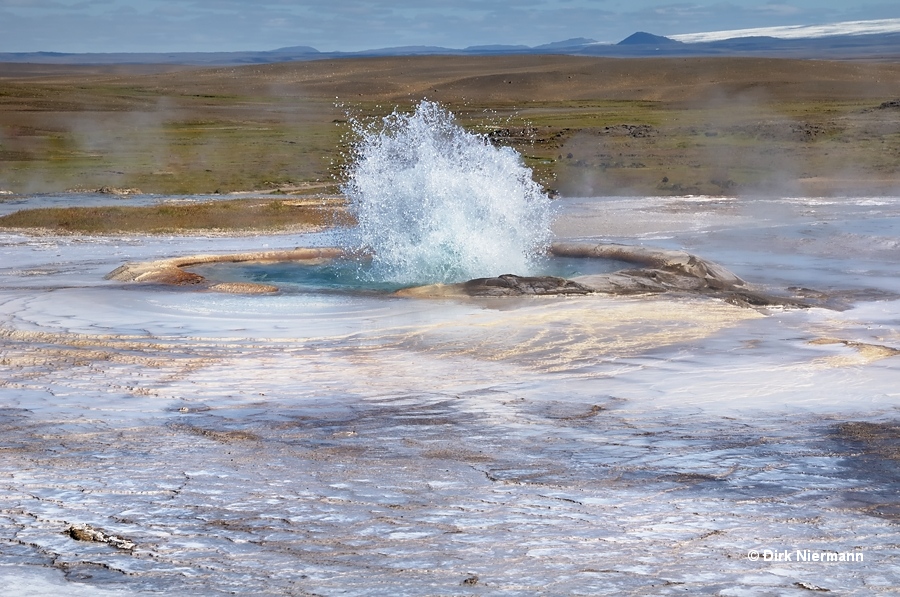The Geysers of Iceland
Even if Geysir, the most famous of Iceland's geysers, is the namesake for all the world's geysers and the group of periodically spouting hot springs as such, Icelanders are regarding "Geysir" as a proper name and are using the term "Goshver" (gushing hot spring) for the class of erupting hot springs. This may cause some confusion if someone is browsing through the Icelandic literature in search for reports about geysers.
In general, the activity of Iceland's geysers is subjected to energy surges by earthquakes to a much higher degree compared to some other geyser fields on earth, for example Yellowstone. So their pacemaker is the activation by an earthquake and decline thereafter at individual rates.

Of course, Iceland is one of the most important geyser sites worldwide. But the question arises, how many and which geysers are to be found. Books and other publications often state a number of 30 geysers without giving a detailed list. The Internet, at least until now (2012), does not provide such an overview either. I have therefore compiled my own list, as shown below.
Unfortunately, information about small and often short living geysers is quite hard to come by, if existing at all. Without systematic observation the problem is on one hand to distinguish between perpetual spouting or true geyser activity, on the other hand that remote features may erupt unnoticed. Therefore, the list focuses on the mostly well known and scientificly documented named geysers. Unnamed geysers, usually inconspicuous small, or remote, or short living, or very recently observed for the first time, are only included if they have shown an noteworthy eruption height of 1 m / 3 feet or more:
- Geysir (active, but currently in phase of minor eruptions, location Haukadalur)
- Strokkur (active, location Haukadalur)
- Óþerrishola (active, location Haukadalur)
- Fata, Fata II (dormant, location Haukadalur)
- Litli Geysir (dormant, location Haukadalur)
- Litli Strokkur (dormant, location Haukadalur)
- Blesi (dormant, location Haukadalur)
- Konungshver (dormant, location Haukadalur)
- unnamed geyser "Álfaauga" (active, location Haukadalur)
- Smiður (dormant, location Haukadalur)
- Sóði (dormant, location Haukadalur)
- Grýla (dormant or extinct, location Hveragerði)
- Dynkur (dormant, location Hveragerði)
- Önnuhver / Ruslahver (dormant, location Hveragerði)
- Hveramoahver (status unknown, location Grændalur north of Hveragerði)
- Grænihver (active, location Hveravellir / Highland)
- Bræðrahver (active, but currently in phase of minor eruptions, location Hveravellir / Highland)
- Bræðraauga (dormant, location Hveravellir / Highland)
- unnamed geyser H209g (active, location Hveravellir / Highland)
- Rauðihver (dormant, location Hveravellir / Highland)
- Eyvindarhver (dormant, location Hveravellir / Highland)
- Gamli Fagrihver (dormant, location Hveravellir / Highland)
- Gjósandi (active, location Hveravellir / Highland)
- Ystihver (active, but currently in phase of minor eruptions, location Hveravellir / Húsavík)
- Uxahver (active, but in phase of minor eruptions and covered by cistern roof, location Hveravellir / Húsavík)
- Syðstihver (dormant, covered by cistern roof, location Hveravellir / Húsavík)
- unnamed mud geyser (active, location Gunnuhver)
- Deildartunguhver (active, location Reykholt in Borgarfjörður, Western Iceland)
- Árhver (active, location Reykholt in Borgarfjörður, Western Iceland)
- Reykholtshver (active, but covered by cistern roof, location Reykholt in Árnessýsla, Southern Iceland)
- Stórihver (status unknown, location Austur-Reykjadalir in Fjallabak Nature Reserve)
- Kátur (status unknown, location Austur-Reykjadalir in Fjallabak Nature Reserve)
Above I have listed some geysers as "dormant", which are regarded as extinct by other authors. The criterion for me to keep them on the list is that they are still fed subterranean with hot water and there is no indication that their plumbing system may be clogged or otherwise damaged. And even if for a long time some of them have been quiet, some have been acting as perpetual spouters, and others have been reaching as boiling or bubble-shower springs only insignificant eruption heights, history has taught us that in the next earthquake they may be back as true geysers.
Extinct geysers from the historic past are:
- Stjarna / Ástarauga at Haukadalur
- Baðstofuhver, unnamed geyser close to Baðstofuhver, Gosi, and Gosi II in Hveragerði
- Litli Geysir, Svaði, Spýtir, Tungarðshver, and unnamed geyser northeast of Spýtir at Reykir near Hveragerði
- Gamli Strokkur and Meyjarauga at Hveravellir / Highland
- Hverinn 1918 at Gunnuhver
- Nýihver at Krýsuvík
- Skrifla, Dynkur, Strokkur, Kopareykir, and Sturlureykjahver at Reykholt in Borgarfjörður
- Syðri Reykir at Reykholt in Árnessýsla, Southern Iceland